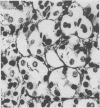Abstract
An intensive histological search for Helicobacter pylori in gastric biopsy specimens has led to the detection of other spiral shaped bacteria in the human gastric mucosa. The clinical and morphological findings of 39 cases (0.25% of all gastric biopsies performed in the observation period) are reported for 34 patients (87.2%) complaining of upper abdominal discomfort. Five patients (12.8%) had chronic gastritis and 34 (87.2%) chronic active gastritis. The organisms were seen by light microscopy deep in the gastric foveolae and intracellularly. The scanning and transmission electron microscopic findings show bacteria which invade and damage gastric mucosal cells. These organisms are similar to the spiral shaped bacteria found in the stomachs of cats and dogs and non-human primates. In eight patients organisms were not detected after four weeks of treatment with bismuth salts. The disappearance of the organisms coincided with resolution of the chronic active gastritis and the symptoms.
Full text
PDF



Images in this article
Selected References
These references are in PubMed. This may not be the complete list of references from this article.
- Dent J. C., McNulty C. A., Uff J. C., Wilkinson S. P., Gear M. W. Spiral organisms in the gastric antrum. Lancet. 1987 Jul 11;2(8550):96–96. doi: 10.1016/s0140-6736(87)92754-1. [DOI] [PubMed] [Google Scholar]
- Hazell S. L., Lee A., Brady L., Hennessy W. Campylobacter pyloridis and gastritis: association with intercellular spaces and adaptation to an environment of mucus as important factors in colonization of the gastric epithelium. J Infect Dis. 1986 Apr;153(4):658–663. doi: 10.1093/infdis/153.4.658. [DOI] [PubMed] [Google Scholar]
- Heilmann K. L., Nowottny U. Histologischer Nachweis von CLO (Campylobacter Like Organisms) in Magenbiopsien. Dtsch Med Wochenschr. 1987 May 22;112(21):861–862. [PubMed] [Google Scholar]
- Heilmann K. L. Spirochäten-ähnliche Bakterien in der menschlichen Magenschleimhaut. Dtsch Med Wochenschr. 1988 Aug 19;113(33):1298–1299. [PubMed] [Google Scholar]
- Jung K., Pergande M., Schimke E., Ratzmann K. P. Harnenzyme und niedermolekulare Proteine als Indikatoren der diabetischen Nephropathie. Klin Wochenschr. 1989;67 (Suppl 17):27–30. [PubMed] [Google Scholar]
- Lee A., Dent J., Hazell S., McNulty C. Origin of spiral organisms in human gastric antrum. Lancet. 1988 Feb 6;1(8580):300–301. doi: 10.1016/s0140-6736(88)90382-0. [DOI] [PubMed] [Google Scholar]
- Lee A., Hazell S. L., O'Rourke J., Kouprach S. Isolation of a spiral-shaped bacterium from the cat stomach. Infect Immun. 1988 Nov;56(11):2843–2850. doi: 10.1128/iai.56.11.2843-2850.1988. [DOI] [PMC free article] [PubMed] [Google Scholar]
- McNulty C. A., Dent J. C., Curry A., Uff J. S., Ford G. A., Gear M. W., Wilkinson S. P. New spiral bacterium in gastric mucosa. J Clin Pathol. 1989 Jun;42(6):585–591. doi: 10.1136/jcp.42.6.585. [DOI] [PMC free article] [PubMed] [Google Scholar]
- Morris A., Ali M. R., Thomsen L., Vanderwee M., Hollis B. Tightly spiral shaped bacteria in gastric antrum: are they urease positive? J Clin Pathol. 1989 Feb;42(2):216–216. doi: 10.1136/jcp.42.2.216-a. [DOI] [PMC free article] [PubMed] [Google Scholar]
- WEBER A. F., HASA O., SAUTTER J. H. Some observations concerning the presence of spirilla in the fundic glands of dogs and cats. Am J Vet Res. 1958 Jul;19(72):677–680. [PubMed] [Google Scholar]








